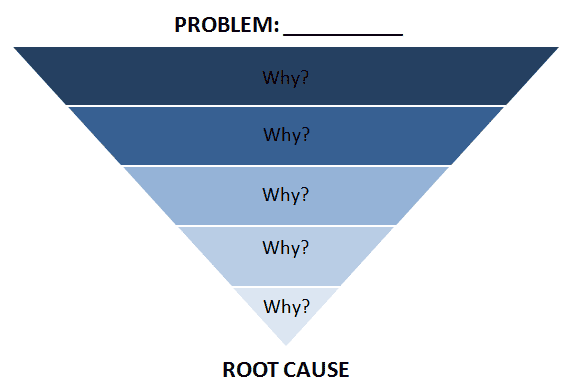![]() Ti ẹgbẹ rẹ ba n koju iṣoro ti o tẹpẹlẹ ti o ti rẹ ọ lati ba sọrọ nigbagbogbo, o le jẹ akoko lati walẹ jinle ki o wa idi gbongbo. Ti o ni ibi ti awọn marun Whys ona igbesẹ ni. Ni yi blog post, a yoo Ye bi o simplify leto complexities nipa béèrè "idi" ni igba marun.
Ti ẹgbẹ rẹ ba n koju iṣoro ti o tẹpẹlẹ ti o ti rẹ ọ lati ba sọrọ nigbagbogbo, o le jẹ akoko lati walẹ jinle ki o wa idi gbongbo. Ti o ni ibi ti awọn marun Whys ona igbesẹ ni. Ni yi blog post, a yoo Ye bi o simplify leto complexities nipa béèrè "idi" ni igba marun.
 Atọka akoonu
Atọka akoonu
 Kí Ni Márùn-ún Kí nìdí Súnmọ́?
Kí Ni Márùn-ún Kí nìdí Súnmọ́? Anfani Of Marun Whys Approach
Anfani Of Marun Whys Approach Bawo ni Lati Waye marun Whys Approach
Bawo ni Lati Waye marun Whys Approach Awọn Marun Whys Apeere
Awọn Marun Whys Apeere Italolobo Fun A Aseyori marun Whys Approach elo
Italolobo Fun A Aseyori marun Whys Approach elo  Awọn Iparo bọtini
Awọn Iparo bọtini FAQs
FAQs
 Kí Ni Márùn-ún Kí nìdí Súnmọ́?
Kí Ni Márùn-ún Kí nìdí Súnmọ́?

 Aworan: CX irin ajo
Aworan: CX irin ajo![]() Ọna Five Whys jẹ ilana-iṣoro-iṣoro ti o jinlẹ lati ṣii idi ti awọn ọran ni awọn ajọ. O kan bibeere “idi” ni igba marun, yiyọ awọn ipele ti iṣoro kan pada lati ṣafihan awọn okunfa ipilẹ rẹ.
Ọna Five Whys jẹ ilana-iṣoro-iṣoro ti o jinlẹ lati ṣii idi ti awọn ọran ni awọn ajọ. O kan bibeere “idi” ni igba marun, yiyọ awọn ipele ti iṣoro kan pada lati ṣafihan awọn okunfa ipilẹ rẹ.
![]() Ọna yii, ti a tun mọ ni 5 Idi tabi 5 Kini idi ti ọna, lọ kọja awọn ojutu ipele-dada, igbega si itupalẹ pipe ti awọn iṣoro. Nigbagbogbo ti a lo ni ipinnu iṣoro ati awọn ilana ṣiṣe ipinnu, ọna Idi marun ti o ṣe iranlọwọ fun awọn ajo ṣe a f
Ọna yii, ti a tun mọ ni 5 Idi tabi 5 Kini idi ti ọna, lọ kọja awọn ojutu ipele-dada, igbega si itupalẹ pipe ti awọn iṣoro. Nigbagbogbo ti a lo ni ipinnu iṣoro ati awọn ilana ṣiṣe ipinnu, ọna Idi marun ti o ṣe iranlọwọ fun awọn ajo ṣe a f![]() ive-idi onínọmbà, idamo awọn otito origins ti awọn italaya lati se diẹ munadoko ati alagbero solusan.
ive-idi onínọmbà, idamo awọn otito origins ti awọn italaya lati se diẹ munadoko ati alagbero solusan.
 Anfani Of The Marun Whys Approach
Anfani Of The Marun Whys Approach
![]() Ọna Five Whys nfunni ni ọpọlọpọ awọn anfani, ṣiṣe ni ọna ti o niyelori fun awọn ẹgbẹ ti n wa ipinnu iṣoro ti o munadoko ati itupalẹ idi root. Eyi ni diẹ ninu awọn anfani bọtini ti ọna 5 Idi:
Ọna Five Whys nfunni ni ọpọlọpọ awọn anfani, ṣiṣe ni ọna ti o niyelori fun awọn ẹgbẹ ti n wa ipinnu iṣoro ti o munadoko ati itupalẹ idi root. Eyi ni diẹ ninu awọn anfani bọtini ti ọna 5 Idi:
 1/ Idanimọ Idi Gbongbo Jin:
1/ Idanimọ Idi Gbongbo Jin:
![]() Ọna Marun Whys tayọ ni ṣiṣafihan awọn idi pataki lẹhin iṣoro kan. Nipa bibeere leralera “kilode,” o fi ipa mu idanwo kikun, ṣe iranlọwọ fun awọn ẹgbẹ lati lọ kọja awọn ami aisan ipele-ilẹ lati ṣe idanimọ awọn ọran pataki.
Ọna Marun Whys tayọ ni ṣiṣafihan awọn idi pataki lẹhin iṣoro kan. Nipa bibeere leralera “kilode,” o fi ipa mu idanwo kikun, ṣe iranlọwọ fun awọn ẹgbẹ lati lọ kọja awọn ami aisan ipele-ilẹ lati ṣe idanimọ awọn ọran pataki.
 2/ Irọrun ati Wiwọle:
2/ Irọrun ati Wiwọle:
![]() Irọrun ti ọna Five Whys jẹ ki o wa si awọn ẹgbẹ ni gbogbo awọn ipele ti ajo kan. Ko si ikẹkọ pataki tabi awọn irinṣẹ idiju ti a nilo, ṣiṣe ni ọna ti o wulo ati titọ fun ipinnu iṣoro.
Irọrun ti ọna Five Whys jẹ ki o wa si awọn ẹgbẹ ni gbogbo awọn ipele ti ajo kan. Ko si ikẹkọ pataki tabi awọn irinṣẹ idiju ti a nilo, ṣiṣe ni ọna ti o wulo ati titọ fun ipinnu iṣoro.
 3/ Iye owo:
3/ Iye owo:
![]() Ṣiṣe ọna Five Whys jẹ iye owo-doko ni akawe si awọn ilana-iṣoro iṣoro miiran. O nilo awọn orisun ti o kere julọ ati pe o le ṣe pẹlu irọrun ipilẹ, ti o jẹ ki o jẹ aṣayan ti o munadoko fun awọn ajo ti o ni awọn isunawo to lopin.
Ṣiṣe ọna Five Whys jẹ iye owo-doko ni akawe si awọn ilana-iṣoro iṣoro miiran. O nilo awọn orisun ti o kere julọ ati pe o le ṣe pẹlu irọrun ipilẹ, ti o jẹ ki o jẹ aṣayan ti o munadoko fun awọn ajo ti o ni awọn isunawo to lopin.
 4/ Ibaraẹnisọrọ Ilọsiwaju:
4/ Ibaraẹnisọrọ Ilọsiwaju:
![]() Ilana ti bibeere “idi” ni ọpọlọpọ igba ṣe iwuri ibaraẹnisọrọ ṣiṣi laarin awọn ẹgbẹ. O ṣe agbega ifowosowopo ati oye ti o pin ti iṣoro naa, n ṣe agbega sihin diẹ sii ati agbegbe iṣẹ ibaraẹnisọrọ.
Ilana ti bibeere “idi” ni ọpọlọpọ igba ṣe iwuri ibaraẹnisọrọ ṣiṣi laarin awọn ẹgbẹ. O ṣe agbega ifowosowopo ati oye ti o pin ti iṣoro naa, n ṣe agbega sihin diẹ sii ati agbegbe iṣẹ ibaraẹnisọrọ.
 5/ Idena Ipadabọ:
5/ Idena Ipadabọ:
![]() Nipa sisọ awọn idi ipilẹ ti iṣoro kan, ọna Five Whys ṣe iranlọwọ fun awọn ajo lati dagbasoke awọn solusan ti o ṣe idiwọ ọran naa lati loorekoore. Ọna imuṣiṣẹ yii ṣe alabapin si ipinnu iṣoro igba pipẹ ati mu imunadoko ti eto-igbimọ lapapọ pọ si.
Nipa sisọ awọn idi ipilẹ ti iṣoro kan, ọna Five Whys ṣe iranlọwọ fun awọn ajo lati dagbasoke awọn solusan ti o ṣe idiwọ ọran naa lati loorekoore. Ọna imuṣiṣẹ yii ṣe alabapin si ipinnu iṣoro igba pipẹ ati mu imunadoko ti eto-igbimọ lapapọ pọ si.
![]() Ọna Five Whys, tabi ọna 5 Whys ti root fa onínọmbà, duro jade fun ayedero rẹ, iye owo-ṣiṣe, ati agbara lati ṣe idanimọ awọn ọran ti o jinlẹ, ti o jẹ ki o jẹ ohun elo ti o niyelori fun awọn ajo ti o ṣe adehun si ilọsiwaju ilọsiwaju ati ipinnu iṣoro.
Ọna Five Whys, tabi ọna 5 Whys ti root fa onínọmbà, duro jade fun ayedero rẹ, iye owo-ṣiṣe, ati agbara lati ṣe idanimọ awọn ọran ti o jinlẹ, ti o jẹ ki o jẹ ohun elo ti o niyelori fun awọn ajo ti o ṣe adehun si ilọsiwaju ilọsiwaju ati ipinnu iṣoro.

 Aworan: freepik
Aworan: freepik Bawo ni Lati Waye marun Whys Approach
Bawo ni Lati Waye marun Whys Approach
![]() Eyi ni itọsọna igbese-nipasẹ-igbesẹ lori bi o ṣe le lo ọna Idi marun:
Eyi ni itọsọna igbese-nipasẹ-igbesẹ lori bi o ṣe le lo ọna Idi marun:
 1/ Ṣe idanimọ iṣoro naa:
1/ Ṣe idanimọ iṣoro naa:
![]() Bẹrẹ nipa asọye kedere iṣoro ti o fẹ koju. Rii daju pe iṣoro naa jẹ pato ati ni oye daradara nipasẹ gbogbo eniyan ti o kan.
Bẹrẹ nipa asọye kedere iṣoro ti o fẹ koju. Rii daju pe iṣoro naa jẹ pato ati ni oye daradara nipasẹ gbogbo eniyan ti o kan.
 2/ Ṣe agbekalẹ ibeere “Kini idi” akọkọ:
2/ Ṣe agbekalẹ ibeere “Kini idi” akọkọ:
![]() Beere idi ti iṣoro naa fi ṣẹlẹ. Gba awọn ọmọ ẹgbẹ niyanju lati pese awọn idahun ti o ṣawari awọn okunfa lẹsẹkẹsẹ ti iṣoro naa. Eyi bẹrẹ ilana iwadii naa.
Beere idi ti iṣoro naa fi ṣẹlẹ. Gba awọn ọmọ ẹgbẹ niyanju lati pese awọn idahun ti o ṣawari awọn okunfa lẹsẹkẹsẹ ti iṣoro naa. Eyi bẹrẹ ilana iwadii naa.
 3/ Tun fun Idahun kọọkan:
3/ Tun fun Idahun kọọkan:
![]() Fun idahun kọọkan si ibeere “idi” akọkọ, beere “idi” lẹẹkansi. Tẹsiwaju ilana yii ni igbagbogbo, ni igbagbogbo ni igba marun tabi titi ti o fi de aaye kan nibiti awọn idahun yoo yorisi idi pataki kan. Bọtini naa ni lati lọ kọja awọn alaye ipele-dada.
Fun idahun kọọkan si ibeere “idi” akọkọ, beere “idi” lẹẹkansi. Tẹsiwaju ilana yii ni igbagbogbo, ni igbagbogbo ni igba marun tabi titi ti o fi de aaye kan nibiti awọn idahun yoo yorisi idi pataki kan. Bọtini naa ni lati lọ kọja awọn alaye ipele-dada.
 4/ Ṣe itupalẹ Idi Gbongbo naa:
4/ Ṣe itupalẹ Idi Gbongbo naa:
![]() Ni kete ti o ba ti beere “idi” ni igba marun tabi ti ṣe idanimọ idi root kan ti o tunmọ si ẹgbẹ naa, ṣe itupalẹ rẹ lati rii daju pe o jẹ ọran ipilẹ nitootọ. Nigba miiran, iwadii afikun tabi afọwọsi le jẹ pataki.
Ni kete ti o ba ti beere “idi” ni igba marun tabi ti ṣe idanimọ idi root kan ti o tunmọ si ẹgbẹ naa, ṣe itupalẹ rẹ lati rii daju pe o jẹ ọran ipilẹ nitootọ. Nigba miiran, iwadii afikun tabi afọwọsi le jẹ pataki.
 5/ Dagbasoke Awọn ojutu:
5/ Dagbasoke Awọn ojutu:
![]() Pẹlu idi root ti idanimọ, ọpọlọ ati ṣe awọn solusan ti o koju taara. Awọn ojutu wọnyi yẹ ki o ṣe ifọkansi lati yọkuro tabi dinku idi root, idilọwọ iṣoro naa lati loorekoore.
Pẹlu idi root ti idanimọ, ọpọlọ ati ṣe awọn solusan ti o koju taara. Awọn ojutu wọnyi yẹ ki o ṣe ifọkansi lati yọkuro tabi dinku idi root, idilọwọ iṣoro naa lati loorekoore.
 6/ Atẹle ati Iṣiro:
6/ Atẹle ati Iṣiro:
![]() Jẹ ki a fi awọn ojutu wa sinu iṣe ki o tọju oju isunmọ lori ipa wọn bi akoko ti nlọ. Ṣe ayẹwo boya iṣoro naa ti yanju ati boya awọn atunṣe eyikeyi si awọn ojutu jẹ pataki.
Jẹ ki a fi awọn ojutu wa sinu iṣe ki o tọju oju isunmọ lori ipa wọn bi akoko ti nlọ. Ṣe ayẹwo boya iṣoro naa ti yanju ati boya awọn atunṣe eyikeyi si awọn ojutu jẹ pataki.

 Aworan: freepik
Aworan: freepik Awọn Marun Whys Apeere
Awọn Marun Whys Apeere
![]() Jẹ ki a rin nipasẹ apẹẹrẹ ti o rọrun ti ọna Five Whys lati ṣe apejuwe bi o ṣe n ṣiṣẹ. Fojuinu oju iṣẹlẹ kan nibiti ẹgbẹ tita rẹ n dojukọ ọrọ kan: Ijabọ Oju opo wẹẹbu Dinku
Jẹ ki a rin nipasẹ apẹẹrẹ ti o rọrun ti ọna Five Whys lati ṣe apejuwe bi o ṣe n ṣiṣẹ. Fojuinu oju iṣẹlẹ kan nibiti ẹgbẹ tita rẹ n dojukọ ọrọ kan: Ijabọ Oju opo wẹẹbu Dinku
![]() Gbólóhùn Isoro: Ijabọ oju opo wẹẹbu dinku
Gbólóhùn Isoro: Ijabọ oju opo wẹẹbu dinku
![]() 1. Kini idi ti ijabọ oju opo wẹẹbu dinku?
1. Kini idi ti ijabọ oju opo wẹẹbu dinku?
 Idahun: Oṣuwọn agbesoke pọ si ni pataki.
Idahun: Oṣuwọn agbesoke pọ si ni pataki.
![]() 2. Kini idi ti oṣuwọn agbesoke pọ si?
2. Kini idi ti oṣuwọn agbesoke pọ si?
 Idahun: Awọn alejo rii akoonu oju opo wẹẹbu ko ṣe pataki.
Idahun: Awọn alejo rii akoonu oju opo wẹẹbu ko ṣe pataki.
![]() 3. Kini idi ti awọn alejo rii akoonu ko ṣe pataki?
3. Kini idi ti awọn alejo rii akoonu ko ṣe pataki?
 Idahun: Akoonu naa ko ni ibamu pẹlu awọn iwulo lọwọlọwọ ati awọn ayanfẹ ti olugbo ibi-afẹde.
Idahun: Akoonu naa ko ni ibamu pẹlu awọn iwulo lọwọlọwọ ati awọn ayanfẹ ti olugbo ibi-afẹde.
![]() 4. Kilode ti akoonu ko ṣe ibamu pẹlu awọn iwulo ati awọn ayanfẹ ti awọn olugbo?
4. Kilode ti akoonu ko ṣe ibamu pẹlu awọn iwulo ati awọn ayanfẹ ti awọn olugbo?
 Idahun: Ẹgbẹ tita ko ṣe iwadii ọja laipẹ lati loye awọn ayanfẹ alabara ti o dagbasoke.
Idahun: Ẹgbẹ tita ko ṣe iwadii ọja laipẹ lati loye awọn ayanfẹ alabara ti o dagbasoke.
![]() 5. Kilode ti ẹgbẹ tita ko ṣe iwadi iwadi ọja laipe?
5. Kilode ti ẹgbẹ tita ko ṣe iwadi iwadi ọja laipe?
 Idahun: Awọn orisun to lopin ati awọn ihamọ akoko ṣe idiwọ agbara ẹgbẹ lati ṣe iwadii ọja deede.
Idahun: Awọn orisun to lopin ati awọn ihamọ akoko ṣe idiwọ agbara ẹgbẹ lati ṣe iwadii ọja deede.
![]() Idi ti gbongbo:
Idi ti gbongbo: ![]() Idi pataki ti ijabọ oju opo wẹẹbu ti o dinku jẹ idanimọ bi awọn orisun to lopin ati awọn idiwọ akoko ti n ṣe idiwọ ẹgbẹ tita lati ṣe iwadii ọja ọja deede.
Idi pataki ti ijabọ oju opo wẹẹbu ti o dinku jẹ idanimọ bi awọn orisun to lopin ati awọn idiwọ akoko ti n ṣe idiwọ ẹgbẹ tita lati ṣe iwadii ọja ọja deede.
![]() Solusan:
Solusan:![]() Pin awọn orisun iyasọtọ fun iwadii ọja deede lati rii daju pe akoonu ṣe deede pẹlu awọn iwulo idagbasoke ati awọn ayanfẹ ti awọn olugbo ibi-afẹde.
Pin awọn orisun iyasọtọ fun iwadii ọja deede lati rii daju pe akoonu ṣe deede pẹlu awọn iwulo idagbasoke ati awọn ayanfẹ ti awọn olugbo ibi-afẹde.
![]() Ninu apẹẹrẹ tita yii:
Ninu apẹẹrẹ tita yii:
 Iṣoro akọkọ jẹ idinku ninu ijabọ oju opo wẹẹbu.
Iṣoro akọkọ jẹ idinku ninu ijabọ oju opo wẹẹbu. Nipa bibeere “idi” ni igba marun, ẹgbẹ naa ṣe idanimọ idi ti gbongbo: awọn orisun to lopin ati awọn idiwọ akoko ti n ṣe idiwọ iwadii ọja deede.
Nipa bibeere “idi” ni igba marun, ẹgbẹ naa ṣe idanimọ idi ti gbongbo: awọn orisun to lopin ati awọn idiwọ akoko ti n ṣe idiwọ iwadii ọja deede. Ojutu naa pẹlu didojukọ idi root nipa pipin awọn orisun ni pataki fun iwadii ọja deede lati mu akoonu dara pọ si pẹlu awọn ayanfẹ olugbo.
Ojutu naa pẹlu didojukọ idi root nipa pipin awọn orisun ni pataki fun iwadii ọja deede lati mu akoonu dara pọ si pẹlu awọn ayanfẹ olugbo.
 Italolobo Fun A Aseyori marun Whys Approach elo
Italolobo Fun A Aseyori marun Whys Approach elo
 Kosi Ẹgbẹ Agbelebu kan:
Kosi Ẹgbẹ Agbelebu kan:  Kojọ awọn ẹni-kọọkan lati awọn ẹka oriṣiriṣi tabi awọn iṣẹ lati ni awọn iwoye oriṣiriṣi lori iṣoro naa.
Kojọ awọn ẹni-kọọkan lati awọn ẹka oriṣiriṣi tabi awọn iṣẹ lati ni awọn iwoye oriṣiriṣi lori iṣoro naa. Ṣe iwuri fun Ibaraẹnisọrọ Ṣii:
Ṣe iwuri fun Ibaraẹnisọrọ Ṣii:  Ṣẹda aaye ailewu fun awọn ọmọ ẹgbẹ ẹgbẹ lati pin awọn oye wọn laisi iberu ẹbi. Tẹnumọ ẹda ifowosowopo ti ilana naa.
Ṣẹda aaye ailewu fun awọn ọmọ ẹgbẹ ẹgbẹ lati pin awọn oye wọn laisi iberu ẹbi. Tẹnumọ ẹda ifowosowopo ti ilana naa. Ṣe iwe ilana naa:
Ṣe iwe ilana naa:  Ṣe igbasilẹ igbasilẹ ti awọn Idiye marun, pẹlu awọn ibeere ti a beere ati awọn idahun ti a pese. Iwe yi le jẹ niyelori fun itọkasi ojo iwaju ati ẹkọ.
Ṣe igbasilẹ igbasilẹ ti awọn Idiye marun, pẹlu awọn ibeere ti a beere ati awọn idahun ti a pese. Iwe yi le jẹ niyelori fun itọkasi ojo iwaju ati ẹkọ. Mura bi o ti nilo:
Mura bi o ti nilo:  Jẹ rọ ninu awọn ohun elo ti awọn Marun Whys. Ti ẹgbẹ ba ṣe idanimọ idi root ṣaaju ki o to beere “idi” ni igba marun, ko si iwulo lati fi ipa mu awọn ibeere afikun.
Jẹ rọ ninu awọn ohun elo ti awọn Marun Whys. Ti ẹgbẹ ba ṣe idanimọ idi root ṣaaju ki o to beere “idi” ni igba marun, ko si iwulo lati fi ipa mu awọn ibeere afikun.

 Aworan: freepik
Aworan: freepik Awọn Iparo bọtini
Awọn Iparo bọtini
![]() Ninu irin-ajo ti iṣoro-iṣoro, ọna Five Whys farahan bi aami-itumọ, awọn ajo ti o ṣe itọsọna si okan ti awọn italaya wọn. Nipa bibeere leralera “idi,” awọn ẹgbẹ le yọ awọn ipele ti awọn ọran lasan kuro, ṣiṣafihan awọn idi gbongbo ti o nilo akiyesi.
Ninu irin-ajo ti iṣoro-iṣoro, ọna Five Whys farahan bi aami-itumọ, awọn ajo ti o ṣe itọsọna si okan ti awọn italaya wọn. Nipa bibeere leralera “idi,” awọn ẹgbẹ le yọ awọn ipele ti awọn ọran lasan kuro, ṣiṣafihan awọn idi gbongbo ti o nilo akiyesi.
![]() Lati mu awọn ohun elo ti awọn marun Whys ona, lilo
Lati mu awọn ohun elo ti awọn marun Whys ona, lilo ![]() AhaSlides
AhaSlides![]() . Ọpa igbejade ibaraenisepo yii le ṣe imudara abala iṣọpọ ti ilana naa, gbigba awọn ẹgbẹ laaye lati pin awọn iṣoro papọ ati ṣe alabapin si irin-ajo wiwa ojutu lainidi. AhaSlides ṣe irọrun ibaraenisepo akoko gidi, ṣiṣe itupalẹ Idi marun ni agbara ati iriri ilowosi fun awọn ẹgbẹ.
. Ọpa igbejade ibaraenisepo yii le ṣe imudara abala iṣọpọ ti ilana naa, gbigba awọn ẹgbẹ laaye lati pin awọn iṣoro papọ ati ṣe alabapin si irin-ajo wiwa ojutu lainidi. AhaSlides ṣe irọrun ibaraenisepo akoko gidi, ṣiṣe itupalẹ Idi marun ni agbara ati iriri ilowosi fun awọn ẹgbẹ.
 FAQs
FAQs
 Kini ilana 5 Whys?
Kini ilana 5 Whys?
![]() Ọna Five Whys jẹ ilana-iṣoro-iṣoro ti o jinlẹ lati ṣii idi ti awọn ọran ni awọn ajọ. O kan bibeere “idi” ni igba marun, yiyọ awọn ipele ti iṣoro kan pada lati ṣafihan awọn okunfa ipilẹ rẹ.
Ọna Five Whys jẹ ilana-iṣoro-iṣoro ti o jinlẹ lati ṣii idi ti awọn ọran ni awọn ajọ. O kan bibeere “idi” ni igba marun, yiyọ awọn ipele ti iṣoro kan pada lati ṣafihan awọn okunfa ipilẹ rẹ.
 Kini ni yii ti 5 Whys?
Kini ni yii ti 5 Whys?
![]() Imọran ti 5 Whys da lori imọran pe nipa bibeere leralera “idi,” ọkan le ṣii awọn ipele ti o jinlẹ ti idi, ti lọ kọja awọn aami aiṣan ipele-ilẹ lati ṣe idanimọ idi pataki ti iṣoro kan.
Imọran ti 5 Whys da lori imọran pe nipa bibeere leralera “idi,” ọkan le ṣii awọn ipele ti o jinlẹ ti idi, ti lọ kọja awọn aami aiṣan ipele-ilẹ lati ṣe idanimọ idi pataki ti iṣoro kan.
 Kini 5 Kí nìdí ilana ẹkọ?
Kini 5 Kí nìdí ilana ẹkọ?
![]() Ilana 5 Idi ti ẹkọ jẹ pẹlu lilo ọna 5 Whys gẹgẹbi ohun elo ẹkọ. O ṣe iranlọwọ fun awọn ọmọ ile-iwe ṣe itupalẹ awọn ọran nipa bibeere lẹsẹsẹ awọn ibeere “idi” lati loye idi ti gbongbo.
Ilana 5 Idi ti ẹkọ jẹ pẹlu lilo ọna 5 Whys gẹgẹbi ohun elo ẹkọ. O ṣe iranlọwọ fun awọn ọmọ ile-iwe ṣe itupalẹ awọn ọran nipa bibeere lẹsẹsẹ awọn ibeere “idi” lati loye idi ti gbongbo.
![]() Ref:
Ref: ![]() Maapu Iṣowo |
Maapu Iṣowo | ![]() Awọn irinṣẹ Mind
Awọn irinṣẹ Mind








